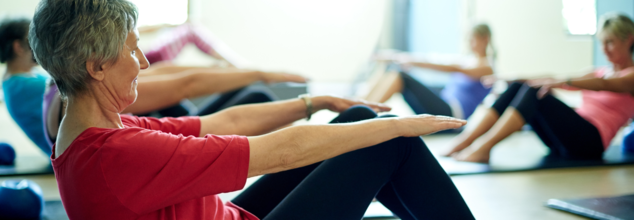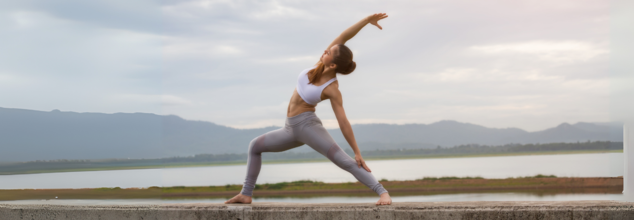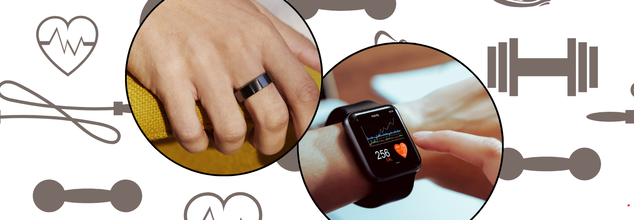- Health Conditions A-Z
- Health & Wellness
- Nutrition
- Fitness
- Health News
- Ayurveda
- Videos
- Medicine A-Z
- Parenting
- Web Stories

Pilates for older people (Credit-Canva)
Is Pilates Good For Older People? How Does It Benefit Them
When we think about exercises for older people, we often picture them going on walks, light cycling or water aerobics. While all of these are great choices have you ever wondered what other exercises older people can venture into? In today’s day and age, any type of exercise is accessible through the internet and videos online but choosing one can be difficult when you have certain limitations. One such exercise that is adaptable and has a place for everyone is Pilates! Pilates is a low-impact exercise method that offers numerous benefits for older adults, including improved bone health, strength, mobility, posture, mood, and even cognitive function. It focuses on aligning and strengthening the body's structure through controlled movements. It recently caught the attention of many fitness freaks and rose to become one of the most popular exercises. Regardless of your current fitness level, Pilates can be adapted to meet your individual needs. With a wide range of targets, you can try Pilates to lose weight, build resilience, build muscle definition and much more.
Some Considerations For Older Adults
Consult your physician before starting Pilates. Beginning with one-on-one sessions with a qualified instructor is highly recommended, allowing for personalized guidance and modifications. Sometimes even we ourselves do not know our limits, so one wrong move could cause severe pain, or even cause long-lasting damage. Group classes specifically designed for older adults are also a good option. Certain Pilates exercises, particularly those involving excessive twisting, flexion (like crunches), and loaded flexion (like rolling on the back), should be avoided by individuals with low bone density or osteoporosis. If done right, here are the benefits of Pilates for older people.
Strengthening Bones
Pilates, especially using equipment like the Reformer, can help maintain bone density, crucial for preventing osteoporosis. This weight-bearing exercise supports bone health, particularly for postmenopausal women.
Improving Posture
Pilates emphasizes alignment and balance, counteracting poor posture and slouching that can result from bone loss. By strengthening and increasing muscle suppleness, it promotes better posture and joint health.
Enhancing Balance
Pilates strengthens core, hips, feet, and ankles, improving balance and coordination essential for daily activities. This reduces the risk of falls and fractures while promoting better movement habits.
Increasing Mobility
Pilates balances strength and flexibility, improving range of motion. Studies show that even six weeks of Pilates can enhance mobility and functional movement in older adults, easing daily tasks and reducing fall risk.
Elevating Mood
As a mindful practice integrating breath and movement, Pilates calms the nervous system and promotes self-awareness. Research suggests it can positively impact mental health, reducing anxiety and depression, especially in group settings.
Supporting Cognitive Function
Regular Pilates practice can improve cognitive function, including memory. Studies have shown improvements in both immediate and recall memory in postmenopausal women following a 12-week Pilates program.
Reducing Back Pain
By strengthening the core, Pilates provides natural support for the spine, reducing back pain. Research indicates that consistent Pilates practice can effectively alleviate chronic lower back pain, often within three months.

(Credit-Canva)
Your Aging Ankles Need These Yoga Poses
While we laud our core strength, leg muscles, as well as our back, for keeping us upright and stable, the role our ankles play is often overlooked. Not only do they keep us stable, but they also reduce the risk of injuries, strong ankles mean better athletic abilities, shock absorption and overall balance.
If you are already worried about weak ankles and feeling unstable in your foundation, picking up a sport or exercises like strength training may not be a good idea. These things can lead your ankles to feel worse. So, to better your ankle health, you need a low impact exercise that is easy on movements but can help you get stronger. Here is where yoga comes into play. Yoga offers low-impact exercises that focus more on flow and movement. There are no movements that require you to jerk your joints or put too much pressure on them.
How Yoga Benefits Your Ankles
Yoga focuses on feet health, helps build the muscles strength present in them. These poses are done in a way that stretches the tight muscles, preventing any imbalances. When you are doing deep stretches, they help improve the blood flow to your feet and ankle. This relieves pain, reduces swelling as well as promoting faster healing. Here are some poses you should try.
Mountain Pose (Tadasana)
Begin by standing tall with your feet positioned hip-width apart. Distribute your body weight evenly across both feet and actively engage the muscles in your legs. Feel a connection to the ground beneath you, focusing on grounding firmly through your feet. Hold this pose for several breaths, noticing the strength and stability in your feet and ankles.
Toe Stretch
Sit comfortably on your heels, then gently tuck your toes underneath you. Slowly shift your weight backward, feeling a mild stretch along the soles of your feet. Maintain this position for a few breaths before releasing. Repeat this stretch several times, gradually increasing the duration as your flexibility improves.
Ankle Circles
Sit with your legs extended straight out in front of you. Place your hands comfortably beside your hips for support. Lift one foot slightly off the ground. Next, rotate your ankle in a circular motion. Perform ten circles in one direction, and then switch to the opposite direction. Repeat these movements with the other foot. This exercise is excellent for enhancing ankle mobility and flexibility.
Warrior Pose (Virabhadrasana)
Stand with your feet positioned wide apart. Turn your right foot outward and bend your right knee, ensuring it stays aligned directly over your ankle. Extend your arms out to the sides, parallel to the floor, like a warrior's stance. Find your balance and stability in your front foot as you hold this pose. Remember to repeat the same steps on the opposite side.
Garland Pose (Malasana)
Squat down with your feet placed hip-width apart and your heels firmly on the ground. Bring your palms together in front of your chest at your heart's centre. Gently press your elbows against your inner thighs, which helps to open your hips. Feel the stretch in your ankles and feet as you hold this pose for several breaths.
Tree Pose (Vrksasana)
Begin by standing tall and then carefully shift your body weight onto your left foot. Bend your right knee and place the sole of your right foot against your inner left thigh or calf. Find your point of balance and bring your hands together at your heart's center. Hold this pose for several breaths, then repeat the same steps on the other side. Tree pose is excellent for strengthening the muscles in your feet and ankles while significantly improving your balance.

Are Smart Rings Worth The Hype? How Do They Compare To Fitness Watches
You're walking through your day, effortlessly monitoring your health, steps, and heart rate without the bulk of a fitness watch on your wrist. Rather, a sleek smart ring lies unnoticed on your finger, working its magic quietly in the background. Interested? You're not the only one. With all the hype over these little tech wonders, people are wondering if they're actually as accurate as their clunky cousins—the fitness watch.
Smart rings are a trendy, minimalist version of the old-style fitness watch and have been widely adopted by health tech buffs, athletes, and even medical practitioners. They come in sleek form, being undistinguishable as jewelry, loaded with strong sensors that can measure sleep, heart rate, and a multitude of wellness indicators. But at what price: reduced accuracy because they are so small? And most importantly, can they really compete with—or even outdo—smartwatches in health monitoring?
The answer is not so simple. Smart rings might be less capable in some respects, but recent studies and developments indicate that they have promising strengths, particularly in the accuracy of some health measurements. Here's an in-depth, exclusive comparison of how smart rings compare to fitness watches.
Smart Rings vs. Smartwatches
At the core of both smart rings and smartwatches lies the same foundational technology—photoplethysmography (PPG). This method uses light-based sensors to measure changes in blood volume, providing real-time data on your heart rate. However, where the device is worn makes a significant difference.
According to a 2022 review in Frontiers in Physiology, the finger is a more vascular-rich area compared to the wrist. That is, smart rings might provide more accurate readings, particularly for heart rate tracking, due to the proximity of the finger to rich blood vessels. Also, a study published in 2023 in Mayo Clinic Proceedings: Digital Health pointed out that smart rings might provide more accurate readings of heart rates in individuals with darker skin. The palm contains less melanin than the wrist, minimizing the light distortion that PPG sensors tend to have trouble with.
However, they have their prerequisites. Motion artefacts—motion-induced interference—can warp smart ring readings, particularly during exercise. According to a 2021 study in the Journal of Electrical Bioimpedance, even minimal movement of the finger during light exercise can invalidate ring-based sensor accuracy. And not like smartwatches, smart rings generally have no onboard GPS and sophisticated accelerometers, thus restricting their use in monitoring challenging workouts or runs.
Even with some immediate limitations, smart rings are rapidly advancing. New prototypes indicate that these wearables may soon far surpass heart rate and sleep tracking. One exciting advance is the result of a January 2024 paper published in IEEE Transactions on Mobile Computing, which introduced a smart ring to track hand hygiene in real time—a revolution in healthcare environments. The ring's electrochemical fluid sensor proved to be 97.8% accurate, more than a 10% improvement over available electronic hygiene monitors.
Another 2021 Computer Modeling in Engineering & Sciences study presented a ring that would be able to sense early hand tremors, an early sign of Parkinson's disease. As research advances, experts envision future rings will even track blood glucose, hydration, and blood pressure—marking the beginning of a new era of passive, ongoing health monitoring.
Sleep Tracking and Wellbeing
When it comes to sleep monitoring, smart rings really shine. Their light, non-intrusive nature makes them perfect for wearing overnight. Unlike smartwatches—which are often found to be cumbersome in bed—smart rings can easily track your sleep without disturbing you.
Brands take it a step further, providing detailed information on energy levels, sleep phases, recovery, and even the best time to consume caffeine. Although a 2024 meta-analysis in Applied Sciences noted that smart rings tend to underestimate REM sleep, they still provide a holistic picture of sleep patterns by integrating data points such as heart rate variability, respiratory rate, and skin temperature.
Nevertheless, experts warn that such rings should be employed to identify trends, not to diagnose sleep disorders. "Smart rings can help identify trends, but they can never replace a sleep study that monitors brain activity," said wearable tech researcher Semitha.
Comfort, Design, and User Preference
Comfort and style are huge pluses for smart rings. They are less obtrusive and better-looking than clunky wrist-mounted devices, making them easier to incorporate into daily wear. But all is not great in the design world. Even with their streamlined marketing, many rings look clunky on smaller hands, and matte finishes tend to wear off after a while with regular use.
Smartwatches, in contrast, have adjustable sizes and removable straps, which may be attractive to those looking for flexibility. Premium smartwatches are more likely to be stronger, since they are manufactured from superior materials and designed to endure intense use.
Which One Is Best for You?
Ultimately, deciding between a smart ring and a smartwatch comes down to your individual health objectives, way of life, and personal comfort level.
If you're a fitness buff requiring precise workout tracking, GPS, and exercise recognition, a smartwatch is still the better choice.
If you're more concerned with sleep quality, daily readiness, recovery, and overall wellness—and don't mind something less invasive—a smart ring could be a game-changer.
For those who value medical-grade accuracy, both devices still lag behind clinical equipment, but smart rings potentially have more future potential because they are closer to high-fidelity data points.
Significantly, neither device is 100% accurate, but both can give you useful insights that enable you to make healthier lifestyle choices.
Smart rings are more than a fad. They are a new convergence of design, health, and technology that will have significant potential to become powerful weapons in personalized healthcare. As technology continues to improve in sensors, the distinction between wearables and medical devices might get blurred, and users could become empowered to take proactive actions towards their healthcare.
In the meantime, these rings can be thought of as hot trend friends to your health journey—not as alternatives to professional health care, but as virtual cues toward improved behaviors.
As the health tech landscape continues to evolve, the finger may just become the most important real estate in wearable innovation. And with every ring that tracks your sleep or your heart rate, we're one step closer to a future where wellness is literally at your fingertips.

(Credit-Canva)
Gym Is Not The Only Place That Can Boost Your Strength And Flexibility
Spending a dedicated time exercising, whether it is an hour or half, could be difficult for some people. If you live alone, or are a homemaker, most of the time goes by taking care of household chores, commuting to and from work, grocery runs and general day to day errands. This leads many people to worry that that they may not be able to lead a healthy lifestyle, but a new study shows that even small movements can prove to be a great addition to your daily life. The study was published in the European Journal of Applied Physiology, and revealed small movements being a great aid to bigger health issues.
Researchers found that people who weren't in the habit of working out saw improvements in their fitness after doing a specific type of exercise for about a month. These improvements included stronger muscles, more stamina to keep going, and better flexibility. This means you don't need to spend hours at the gym to start feeling healthier; even short bursts of activity can make a real difference.
Can Small Movements Make A Big Difference?
The type of exercise the study focused on is called ‘eccentric exercise’- movement emphasizes the part of an exercise where your muscles are lengthening. Think about slowly lowering any weighted object after you lift it and gently going down into a squat. Research has shown that this type of exercise is easier on your body compared to other types of workouts, and it's very effective at helping your muscles grow stronger and bigger. It's a smart way to build muscle without putting too much strain on your body, making it a good option for people who are just starting to exercise.
Even a small amount of this type of movement done regularly can provide noticeable benefits for your fitness. This is encouraging news for people who might feel like they don't have much time or energy to dedicate to exercise. It shows that even short, simple routines can have a real impact on your strength, endurance, and flexibility, making it easier to do everyday activities.
The participants, mostly women, went through a short period to get used to the study before starting a four-week routine of eccentric exercises. Every day, they performed ten repetitions of four easy exercises- chair squats (standing up and sitting down using a chair), chair reclines (leaning back slightly while seated), wall push-ups, and heel drops (raising up onto their toes and slowly lowering their heels).
After the four weeks of daily eccentric exercises, the researchers found some interesting results. While there weren't big changes in things like body composition, resting heart rate, or blood pressure, the participants did show significant improvements in their ability to do sit-ups and push-ups. They also performed better on the three-minute step test, which measures cardiovascular endurance. Additionally, their flexibility improved, and they reported feeling better mentally. This suggests that even a small amount of daily exercise can lead to noticeable and lasting fitness benefits for people who are not regularly active.
Exercises You Can Perform At Home
Chair squats: standing up and sitting down using a chair
Chair reclines: leaning back slightly while seated
Wall push-ups: placing your palms on the wall and pushing against it
Heel drops: raising up onto their toes and slowly lowering their heels
Tips To Help You Get Started With Eccentric Training
If you're interested in trying eccentric training, remember that you don't have to stick to the exact exercises used in the study. Almost any exercise can include an eccentric component. If you're not very active right now, you'll likely still see progress even if you start with low intensity and very short exercise sessions. Experts suggest starting with just five minutes a day and aiming for around ten repetitions of each exercise. This can be a good starting point to see what's possible, and from there, you can gradually increase the intensity or how long you exercise to keep improving your fitness.
© 2024 Bennett, Coleman & Company Limited

